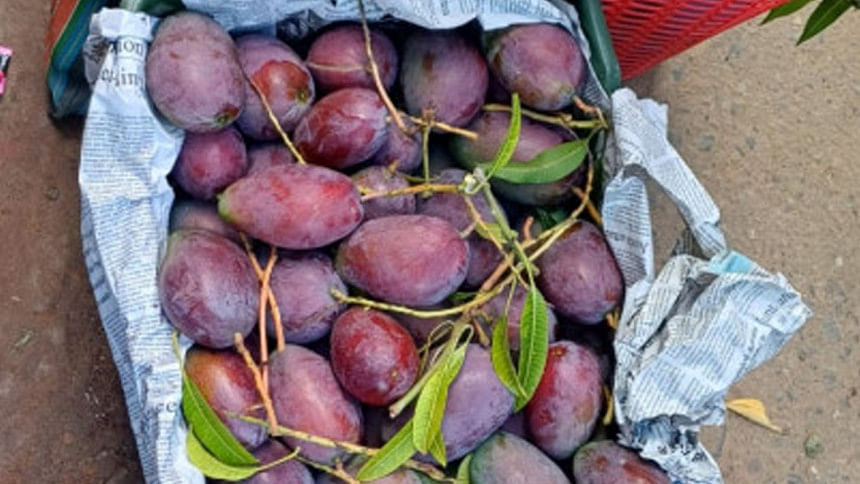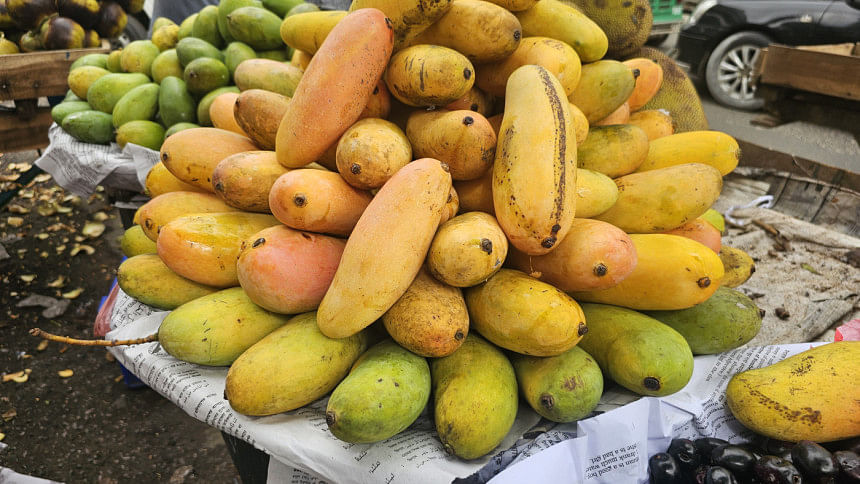Foreign mango varieties gain popularity in hill tracts

Alongside local mango varieties, various foreign types of mangoes are now being cultivated in the three hill districts. The hilly orchards are currently adorned with colourful and flavourful mangoes. This year, the harvest has been abundant.
Last year, the three hill districts of the country produced over 200,000 tonnes of mangoes. This year, production is expected to be even higher, according to officials involved.
There was a time when people in the Chattogram region had to wait for mangoes from the northern parts of the country. But that is no longer the case. The mangoes produced in the three hill districts are now meeting a significant portion of the demand in the Chattogram region and are also being supplied to other districts across the country.

According to the Department of Agricultural Extension, mangoes are being cultivated on 3,620 hectares of land in Rangamati district. In Bandarban, both local and foreign mango varieties are being grown on 10,239 hectares, and in Khagrachhari, mango cultivation covers 4,421 hectares.
Md Nasim Haider, Chief Agricultural Officer of the Department of Agricultural Extension in the three hill districts, said mango cultivation has increased in the hilly areas. Many hobbyist orchard owners are cultivating various foreign mango varieties out of passion and are getting good yields. However, these foreign mangoes have not yet reached full-scale commercial production, he said.
Orchard owners in the three hill districts report that mango cultivation is increasing day by day. Previously, only local varieties were grown, but now foreign varieties such as the Japanese "Miyazaki", Thai "Katimon", "Red Palmer", "Banana mango", "Brunei King", "Kyojai", "Valencia Pride", and "Kensington Pride" are also being produced.

The orchard owners said these mangoes are attracting buyers due to their excellent taste and being free from formalin. They are also providing new income opportunities for local farmers.
Mohammad Rafique, a wholesale fruit trader from Bandarban, said both local and foreign mangoes are now reaching not only local markets but also Chattogram, Dhaka, and the tourist city of Cox's Bazar.
A visit to various hilly markets revealed that depending on size and variety, local mangoes such as "Rupali" (Amrapali) and "Rangwai" are being sold at prices ranging from Tk 60 to 100 per kg. Among the foreign varieties, "Red Palmer" is selling at Tk 300, "Banana" at Tk 200, "Kyojai" at Tk 180, and 'Red Queen' at Tk 300 per kg.
In Sindukchhari, Khagrachhari, Lashi Mong Marma has cultivated various foreign mango varieties on 25 acres of hilly land. His cultivation of the Japanese 'Miyazaki' mango in the hill tracts has created quite a stir.
Lashi Mong Marma said, "I'm cultivating many foreign mango varieties in my orchard. I've been maintaining mango orchards in the hills for about 10–12 years. I started growing foreign mangoes as a hobby, and I'm getting good yields. Many people come from far away to see these mangoes."
In Bandarban, Shahadat Hossain, a businessman from Chattogram, has established an orchard of foreign mangoes. "I started importing popular mango varieties from different countries and began setting up orchards around 8–10 years ago. Now the trees are bearing good fruit. These tasty mangoes are very enjoyable to eat and fetch good prices in the market."
Meanwhile, officials from the Department of Agricultural Extension in Bandarban reported that this year's mango harvest in the district has been abundant. About 60 percent of the yield is from the Rangwai variety, 30 percent from Amrapali, and 10 percent from other foreign varieties.
According to officials, training programmes for farmers are helping to expand mango cultivation in the region.

 For all latest news, follow The Daily Star's Google News channel.
For all latest news, follow The Daily Star's Google News channel. 



Comments